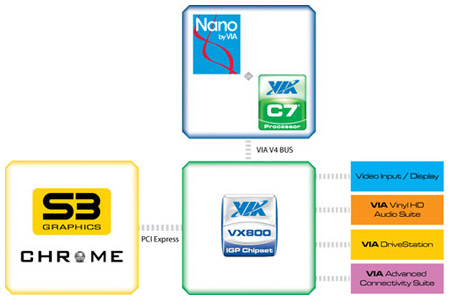Despite claiming that its "Nano is definitely faster" than Intel's Atom processor, there's no denying that VIA has failed to make a significant impact with its low-power 64-bit Nano processors.
Having launched amid a touch of fanfare back in May, we'd struggle to name just a couple of netbooks that opt for VIA's Nano over Intel's dominant Atom. Still, the Taiwan-based manufacturer isn't giving up yet.
Today, it's announcing a three-fold alternative to Intel's dominance - the VIA Trinity platform. Trinity, a 3-chip silicon platform, consists of a VIA Nano processor, a VIA chipset/media system processor and an S3 Graphics discrete GPU. The three-way combo, says VIA, delivers "HD performance to ultra compact systems for a far richer user experience".

Taking a look at the block diagram - and ignoring the ageing optional C7 processor - it's a promising little solution. The example chipset, VIA's VX800, is an all-in-one integrated solution that features a DirectX 9 IGP and combines North and South bridges onto a single chip. Throw in say a 1.6GHz Nano CPU and a Chrome 440 ULP GPU and you're got a low-power and small-form-factor system that's able to dish out high-def 1080p media and DirectX 10.1 graphics.
Richard Brown, vice president of marketing at VIA Technologies, states:
With Mini-ITX 2.0, we declared that small form factor meant no compromise on essential technologies or performance. The VIA Trinity platform is a natural extension of that philosophy for ultra compact systems. This platform leverages VIA's long-standing expertise in shrinking the form factor to deliver a truly high definition experience in small devices, perfect for a variety of lifestyles and applications.
The platform seems to have some merit, but who'll dare sway away from the tried-and-trusted Atom? Particularly with NVIDIA's Atom-boosting ION platform around the corner.
Official press release: VIA Trinity Platform Brings Hi-Def to Small Spaces













